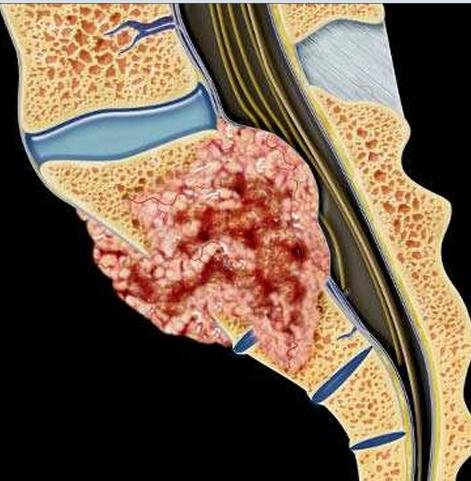Osteosarcoma
Osteosarcoma
Pediatric spinal osteosarcoma is a rare and aggressive malignant bone tumor originating from osteoblasts, primarily affecting the vertebral bones of children and adolescents. Osteosarcoma is more commonly found in the long bones, but when it arises in the spine, it poses unique challenges due to the proximity to the spinal cord and nerve roots. In Bangladesh, early detection and advanced management of spinal osteosarcoma in children remain limited by resource constraints and delayed referrals. Dr. Md. Nafaur Rahman, a leading pediatric neurosurgeon, offers expert surgical intervention and coordinates comprehensive multidisciplinary care to improve survival and quality of life for affected children. What is Pediatric Spinal Osteosarcoma? Osteosarcoma is the most common primary malignant bone tumor in children and adolescents, characterized by the production of immature bone (osteoid) by malignant cells. When it involves the spinal vertebrae, it is called spinal osteosarcoma. Key Features: Typically affects children aged 10 to 20 years Highly aggressive and rapidly growing tumor Can cause spinal instability and neurological deficits due to spinal cord compression Requires aggressive treatment including surgery, chemotherapy, and sometimes radiotherapy Causes and Risk Factors The exact cause is unknown; genetic mutations and environmental factors may contribute Increased risk in children with prior radiation exposure or certain bone diseases No hereditary pattern established Not related to trauma or infections Clinical Presentation Symptoms of pediatric spinal osteosarcoma are often nonspecific initially but progress as the tumor grows: Persistent back or neck pain, often worsening at night Palpable swelling or deformity over the spine Progressive limb weakness or numbness due to spinal cord or nerve root compression Difficulty walking or gait instability Bladder or bowel dysfunction in advanced cases General symptoms such as fatigue or weight loss in some children Due to symptom overlap with common spinal infections like tuberculosis in Bangladesh, early diagnosis can be difficult without appropriate imaging. Diagnostic Workup in Bangladesh Accurate diagnosis requires a combination of clinical evaluation, imaging, and tissue diagnosis: Clinical Examination Detailed neurological and musculoskeletal assessment Checking for spinal tenderness, deformity, and neurological deficits Imaging X-rays to detect bone destruction, periosteal reaction, or new bone formation MRI of the spine to evaluate tumor extent, spinal cord compression, and soft tissue involvement CT scan for detailed bone evaluation and surgical planning Bone scan or PET scan to detect metastatic disease Biopsy to confirm diagnosis through histopathology and immunohistochemistry Treatment Modalities Management of pediatric spinal osteosarcoma requires a multidisciplinary approach involving pediatric neurosurgeons, oncologists, radiologists, and rehabilitation experts. Surgical Intervention by Dr. Md. Nafaur Rahman Aim to achieve maximum safe tumor resection while preserving neurological function Decompression of the spinal cord to relieve symptoms and prevent further damage Spinal stabilization and reconstruction using instrumentation to maintain spinal integrity Use of microsurgical and advanced neurosurgical techniques under intraoperative monitoring Chemotherapy and Radiotherapy Pre- and post-operative chemotherapy is essential for systemic disease control and improved survival Radiotherapy may be used in cases where surgical resection is incomplete or inoperable tumors Treatment protocols follow international standards, adapted to local healthcare facilities Prognosis and Follow-up Early diagnosis and complete surgical removal combined with chemotherapy significantly improve prognosis Spinal osteosarcoma is aggressive with potential for local recurrence and distant metastasis, especially to lungs Lifelong follow-up is necessary to monitor for tumor recurrence and manage long-term treatment effects Rehabilitation is crucial to regain motor function and enhance quality of life Challenges in Bangladesh Lack of widespread awareness leading to delayed diagnosis Confusion with spinal infections like tuberculosis, common in Bangladesh Limited access to advanced imaging and pediatric oncology centers outside major cities Financial and logistical barriers impacting comprehensive care and follow-up Need for strengthening multidisciplinary pediatric oncology and neurosurgery collaboration Why Trust Dr. Md. Nafaur Rahman? Expertise in complex pediatric spinal tumor surgeries with focus on neurological preservation Affiliated with the National Institute of Neurosciences & Hospital (NINS), the premier neurosurgical center in Bangladesh Chief Consultant at Bangladesh Paediatric Neurocare Centre, dedicated to children’s neurosurgical care Committed to holistic patient care, combining surgery, chemotherapy coordination, and rehabilitation Active in raising awareness and training healthcare professionals across Bangladesh Contact and Appointment Dr. Md. Nafaur Rahman Assistant Professor, Pediatric Neurosurgery National Institute of Neurosciences & Hospital (NINS) Chief Consultant, Bangladesh Paediatric Neurocare Centre 📞 For Appointment / Serial: 📱 01912988182 | 01607033535 🌐 Website: www.neurosurgeonnafaur.com










